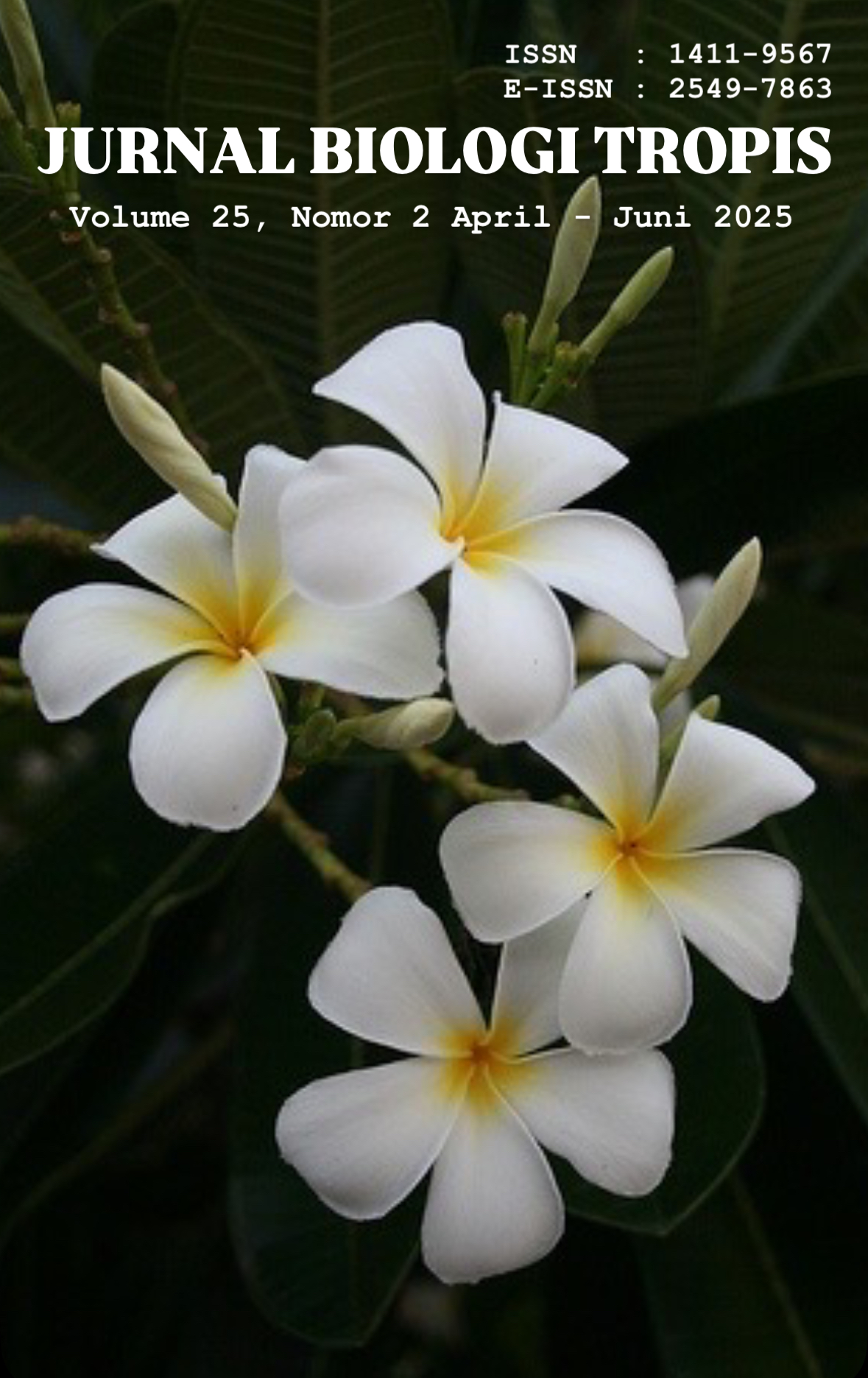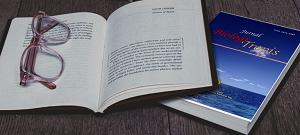Growth Curve and Antibacterial Activity Test of Endophytic Bacteria Isolates 1 (IBE1) from Labu Koteka (Lagenaria siceraria) Against Escherochoa coli, Pseudomonas aeruginosa and MRSA
Authors
Silvy Rizka Putri , Akmal Djamaan , Anthoni AgustienDOI:
10.29303/jbt.v25i2.8506Published:
2025-04-22Issue:
Vol. 25 No. 2 (2025): April-JuniKeywords:
Antibiotic, drug discovery, secondary metabolite.Articles
Downloads
How to Cite
Downloads
Metrics
Abstract
The rising incidence of antibiotic-resistant bacteria presents a considerable global health threat, requiring the immediate creation of new antimicrobial drugs. A possible strategy involves investigating antibiotics sourced from endophytic bacteria, which are microorganisms that inhabit plant tissues symbiotically. This research is to assess the inhibitory efficacy of endophytic bacteria derived from Lagenaria sicerari against, Escherichia coli, Pseudomonas aeruginosa, and methicillin-resistant Staphylococcus aureus (MRSA). The identified endophytic bacteria were cultivated in a fermentation medium to synthesize antibiotics, and their growth curves were examined. Subsequently, antibacterial activity assays were performed against the three harmful bacteria, measuring the sizes of the clear inhibitory zones. The results indicated that Isolated Bacteria Endophytic (IBE) 1 attained optimal inoculum levels at 24 hours and sustained the stationary phase from 24 to 36 hours. The isolates exhibited optimum fermentation on a medium utilizing glucose as the carbon source, with a carbon-to-nitrogen ratio of 5. IBE 1 had the most effective antibacterial action against P. aeruginosa, with a moderate inhibition characterized by clear zone widths of 10.80 mm. The findings indicate that endophytic bacteria from Lagenaria siceraria may serve as promising sources of new antimicrobial drugs, especially against Pseudomonas aeruginosa.
References
Ajizah, N. L., Wijaya, I. M. M., & Antara, N. S. (2021). Variasi konsentrasi glukosa pada media tumbuh dan lama fermentasi dalam memproduksi etanol oleh isolat BM-CP14. Jurnal Rekayasa dan Manajemen Agroindustri, 9(2), 208-218..
Akalin, H. E. (2002). Surgical prophylaxis: the evolution of guidelines in an era of cost containment. Journal of hospital infection, 50, S3-S7. doi: 10.1053/jhin.2001.1121
Astari, S. M., Rialita, A., & Mahyarudin, M. (2021). Aktivitas Antibakteri Isolat Bakteri Endofit Tanaman Kunyit (Curcuma longa L.) Terhadap Pertumbuhan Staphylococcus aureus. Jurnal Fitofarmaka Indonesia, 8(2), 9-16.
Azizah, N., Al-Barrii, A. N., & Mulyani, S. (2012). Pengaruh lama fermentasi terhadap kadar alkohol, pH, dan produksi gas pada proses fermentasi bioetanol dari whey dengan substitusi kulit nanas. Jurnal Aplikasi Teknologi Pangan, 1(3).
Brock, T. D., & Madigan, M. T. (1991). Host-Microbe relationships and disease processes. Biology of Microorganisms 6th edition. Prentice-Hall Inc, 379-380.
Caldwell, D. R. (1995). Microbial physiology and metabolism. Wm. C. C. Brown.
Castillo, U. F., Strobel, G. A., Ford, E. J., Hess, W. M., Porter, H., Jensen, J. B., ... & Yaver, D. (2002). Munumbicins, wide-spectrum antibiotics produced by Streptomyces NRRL 30562, endophytic on Kennedia nigriscans. Microbiology, 148(9), 2675-2685. DOI: 10.1099/00221287-148-9-2675
CDC. (2013). Pseudomonas aeruginosa in Healthcare Settings. Tersedia di: http://www.cdc.gov/hai/organisms/pseudomonas.html [diakses: 7 November 2014].
Davis, W. W., & Stout, T. R. (1971). Disc plate method of microbiological antibiotic assay: I. Factors influencing variability and error. Applied microbiology, 22(4), 659-665. DOI: 10.1128/am.22.4.659-665.1971
Djamaan, A., Agustien, A., & Yuni, D. (2012). Isolasi bakteri endofit dari tumbuhan surian (Toona sureni blome. M) yang berpotensi sebagai anti bakteri. Jurnal Bahan Alam Indonesia, 8(1), 37-40.
Djamaan, A., Asia, A., & Wahyuni, R. (2017). Isolasi mikroba endofit dari kulit batang, daun, dan kulit buah manggis (Garcinia mangostana L.) pengkulturan serta uji aktivitas antimikrobanya. Jurnal Farmasi Higea, 6(1), 90-97.
El-Banna, N. M. (2006). Effect of carbon source on the antimicrobial activity of Corynebacterium kutscheri and Corynebacterium xerosis. African Journal of Biotechnology, 5(10).
Elibol, M. (2004). Optimization of medium composition for actinorhodin production by Streptomyces coelicolor A3 (2) with response surface methodology. Process Biochemistry, 39(9), 1057-1062. DOI: 10.1016/j.procbio.2003.05.002
Heni, S. A., & Zaharah, T. A. (2015). Efektivitas antibakteri ekstrak kulit batang belimbing hutan (Baccaurea angulata Merr.) terhadap Staphylococcus aureus dan Escherichia coli. Jurnal Kimia Khatulistiwa, 4(1).
Kusumaningati, M. A., Nurhatika, S., & Muhibuddin, A. (2013). Pengaruh konsentrasi inokulum bakteri Zymomonas mobilis dan lama fermentasi pada produksi etanol dari sampah sayur dan buah Pasar Wonokromo Surabaya. Jurnal Sains dan Seni ITS, 2(2), E218-E223.
Kusumawati, N., Estikomah, S. A., & Amal, S. (2018). Uji Efektivitas Air Perasan Jeruk Nipis (Citrus Aurantifolia) Dan Madu Randu Dalam Menghambat Pertumbuhan Bakteri Propionibacterium acnes. Pharmasipha: Pharmaceutical Journal of Islamic Pharmacy, 2(2), 17-22.
Madigan, M. T., Martinko, J. M., Stahl, D. A., & Clark, D. P. (2012). A brief journey to the microbial world. Brock biology of microorganisms, 13th edition. Benjamin Cumings, New York, 25-30
Marliana, E., & Saleh, C. (2011). Uji fitokimia dan aktivitas antibakteri ekstrak kasar etanol, fraksi n-heksana, etil asetat dan metanol dari buah labu air (Lagenari siceraria (molina) standl). Jurnal Kimia Mulawarman, 8(2), 63-69.
Nasrun, N., Jalaluddin, J., & Mahfuddhah, M. (2017). Pengaruh jumlah ragi dan waktu fermentasi terhadap kadar bioetanol yang dihasilkan dari fermentasi kulit pepaya. Jurnal Teknologi Kimia Unimal, 4(2), 1-10. DOI: https://doi.org/10.29103/jtku.v4i2.68.
Reddell, P., & Gordon, V. (2000). ‘Lessons from nature’: can ecology provide new leads in the search for novel bioactive chemicals from tropical rainforests?. The Royal Society of Chemistry, Cambridge, UK, 205-212.
Respati, N. Y., Yulianti, E., & Rahmawati, A. (2017). Optimasi suhu dan pH media pertumbuhan bakteri pelarut fosfat dari isolat bakteri termofilik. Kingdom (The Journal of Biological Studies), 6(7), 423-430.
Robinson T. (1995). Kandungan organik tumbuhan tinggi. Terjemahan: Koensoemardiyah. IKIP Semarang Press, Semarang.
Sastrapradja, S. (1980). Sayur-sayuran. Jakarta : Balai Pustaka.
Shah, B. N., Seth, A. K., & Desai, R. V. (2010). Phytopharmacological profile of Lagenaria siceraria: A review. Asian Journal of Plant Sciences.
Shore, S. J., & Sathisha, G. (2010). Screening of endophytic colonizing bacteria for cytokinin-like compounds: crude cell-free broth of endophytic colonizing bacteria is unsuitable in cucumber cotyledon bioassay. World Journal of Agricultural Sciences, 6(4), 345-352.
Simanjuntak, P., Bustanussalam, O. D., Rahayuningsih, M., & Said, E. G. (2004). Isolasi dan identifikasi artemisinin dari hasil kultivasi mikroba endofit dari tanaman Artemisia annua. (Studi mikroba endofitik tanaman Artemisia spp.). Majalah Farmasi Indonesia, 15(2), 68-74.
Subagiyo, S., Margino, S., & Triyanto, T. (2016). Pengaruh Penambahan Berbagai Jenis Sumber Karbon, Nitrogen Dan Fosforpada Medium deMan, Rogosa and Sharpe (MRS) Terhadap Pertumbuhan Bakteri Asam Laktat Terpilih Yang Diisolasi Dari Intestinum Udang Penaeid. Jurnal Kelautan Tropis, 18(3), 127-132.
The Wealth of India, (2004). A Dictionary of Indian raw materials & industrial products. CSIR, New Delhi III, 16‐19
Utami, E. R. (2011). Antibiotika, resistensi, dan rasionalitas terapi. Sainstis. Vol 1, No 1, ISSN:2089-0699
License
Copyright (c) 2025 Silvy Rizka Putri, Akmal Djamaan, Anthoni Agustien

This work is licensed under a Creative Commons Attribution 4.0 International License.

Jurnal Biologi Tropis is licensed under a Creative Commons Attribution 4.0 International License.
The copyright of the received article shall be assigned to the author as the owner of the paper. The intended copyright includes the right to publish the article in various forms (including reprints). The journal maintains the publishing rights to the published articles.
Authors are permitted to disseminate published articles by sharing the link/DOI of the article at the journal. Authors are allowed to use their articles for any legal purposes deemed necessary without written permission from the journal with an acknowledgment of initial publication to this journal.


























